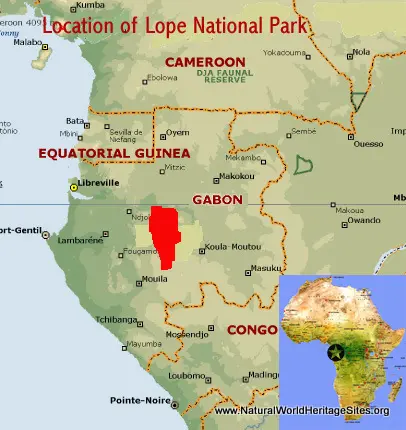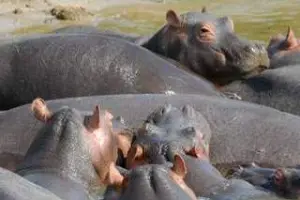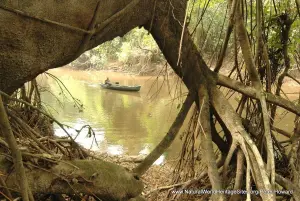EXPLORE GABON’S LOPE-OKANDA LANDSCAPE with this slideshow, check the location map and get all the facts and information below.
For slideshow description see right or scroll down (mobile). Click to view slideshow
Values: This park protects one of the most diverse tracts of rainforest in the Congo Basin, interspersed with very ancient man-made savannas, creating a mosaic of grasslands and forests. The fauna includes 84 species of mammals and 405 birds, including many little-known forest species. There are more globally threatened species than at any other Congo rainforest site, including western lowland gorilla, mandrill, chimpanzee, and the endemic suntailed guenon (which was only discovered in 1994). The forest-savanna interface typical of central Gabon is well preserved in the park, and ecological and archaeological evidence shows that the area was inhabited almost continuously from late Palaeolithic times 350-400,000 years ago to the present. Scattered across the landscape is an exceptional archaeological record of successive cultures including the remains of Palaeolithic tools, Neolithic villages of 4,000 years BP and Iron Age metal-working sites from 2,500 years ago.
A comprehensive review of the world heritage values of the site is provided below, together with details of the area’s conservation status and the threats it faces.
REVIEW OF WORLD HERITAGE VALUES: According to IUCN’s Conservation Outlook Assessment (2014), the specific natural attributes which qualify the Ecosystem and Relict Cultural Landscape of Lope-Okanda for world heritage status can be summarised as follows:
- Important populations of globally threatened forest mammals. Lope-Okanda supports a higher concentration of threatened species of large mammals than any other comparable area in the Congo Basin rainforests. In particular, it supports one of the biggest concentrations of wild primates in the world, including gorillas and chimpanzees as well as high densities of large monkeys, such as mandrills (with densities of 2.2 / km²). Lope National Park has the only significant population of sun-tailed monkey living within a protected area, and its northern Marantaceae forest supports (on a seasonal basis) the highest density of forest elephants in the world (1.5 elephants / km²).
- Exceptional diversity of plant species and habitats. The complex relationship between forest and savanna ecosystems has resulted in exceptionally high biological diversity, and a unique complexity of habitats not found elsewhere in the Congo Basin rainforests. More than 1550 species of plants have been described so far (including 40 that are not recorded elsewhere in Gabon) and it is thought that further research may reveal a total of around 3000 species.
- Unusual interface between forest and savanna environments. Lope-Okanda is characterised by an unusual interface between savanna and forest environments, reflecting ongoing ecological processes as species and habitats adapt to post-glacial climatic changes as well as long-standing interaction between early human settlers and nature.
CONSERVATION STATUS AND PROSPECTS: The overall outlook for conservation of the Ecosystem and Relict Cultural Landscape of Lope-Okanda is good, although there are a number of concerns. The large size of the Lope National Park, and low human population density in surrounding areas means that human pressures for subsistence use of the park’s resources are limited, but commercial poaching (for ivory and bushmeat), illegal logging, and major infrastructure developments in and around the park are more significant threats. Logging concessions in surrounding areas will enable better access to the park and may facilitate poaching and other illegal activities.
MANAGEMENT EFFECTIVENESS: The financial and human resources available for management are currently inadequate to manage a site of this size (for example, only 14 rangers are available for law enforcement operations). A management plan has been developed for the 2013-17 period, and its implementation is being supported by a number of international donors. Gabon’s national park management authority is a relatively new institution with enormous challenges related to the surge in ivory poaching, the need to engage with local communities and address emerging threats such as those related to major infrastructure, logging and other commercial activities in surrounding areas. The last animal census was carried out in 2006, so there is no information on the impact of the present continent-wide surge in elephant poaching for ivory.
REVIEW OF CONSERVATION ISSUES AND THREATS: The following issues represent specific threats to the ecology, conservation and values of the Lope-Okanda world heritage site.
Subsistence hunting. Local people living in villages around the park have the right to customary use of resources from the area, which can lead to localised depletion of wildlife.
Illegal commercial hunting (poaching). Commercial poaching is a major threat affecting a wide range of wildlife including elephants (for ivory), buffalo, gorillas, chimpanzees, duiker, bush pig and many others. It is facilitated by the railway which runs along the park’s northern boundary and by access through logging concessions in areas to the west of the park. These transport corridors make it easy for poachers to gain access to the park, and export bushmeat and ivory to Libreville and other markets.
Commercial logging. Logging concessions have been awarded covering 50% of the buffer zone, and these are now becoming operational (following some delays while management plans were developed). Areas to the west of the park are particularly affected, and these areas will be ‘opened up’ with access roads and an influx of forestry workers. Experience elsewhere suggests that this is likely to result in increased poaching, and require extra vigilance in patrol and protection work. Access into the park by poachers has also been facilitated by a network of old roads built in the 1980s when northern parts of what is now designated as park were managed as logging concessions.
Wood harvesting by local communities. Some members of villages around the park (as well as small-scale commercial operators who have no legal authority) undertake tree-cutting in the vicinity of their homes. This has a limited localised impact on the site.
Agricultural encroachment. Slash and burn agriculture is widely practised in the areas surrounding the park and in several designated village enclaves within it, so there is a risk that this will be extended across the park boundary as land-use pressure intensifies. However this is not presently a significant problem.
Vegetation change. Under present conditions the areas of savanna vegetation are tending to be replaced with closed canopy forest. A dynamic equilibrium is likely to exist with changes in rainfall and climate tilting the ecological balance in favour of forest or savanna vegetation at any particular time.
Invasive Alien Species. Old disused logging tracks in the north of the park have been colonised by the little fire ant, (Wassmannia auropunctata) a native of central and south America. It is not known what impact this species is having on the local fauna, and no detailed assessment of other potentially invasive alien species has been carried out at the site.
Road and railway transport corridor. There are a number of planned national infrastructure projects through the northern part of the site, along the Ogooué river valley. This area is rich in ancient rock art and other archaeological remains which would be especially vulnerable to such developments. The proposed developments include an upgrading of the (existing) national highway; extension of the railway as part of a proposed iron ore mining operation, and installation of a fibre-optic line through the site. In response to concerns from the international community, an alternative routing for the road has been found, but the railway extension is likely to go ahead, bringing a dramatic increase in rail traffic and corresponding numbers of animals killed by passing trains (an average of five elephants and/or buffalo are killed annually at present).
Links:
Google Earth
Official UNESCO Site Details
IUCN Conservation Outlook
UNEP-WCMC Site Description
Birdlife IBA
Slideshow description
The slideshow provides a comprehensive overview of Gabon’s Ecosystem and Relict Cultural Landscape of Lope-Okanda, showing the area’s tropical forest and savanna landscapes, wildlife habitats, plants and animals, threatened species, conservation management issues and local community livelihoods.
Factfile
Website Category: Tropical and Sub-tropical Forests
Area: 4,913 km2
Inscribed: 2007
Criteria:
- (ix) ecological processes;
- (x) biodiversity (and cultural criteria (iii), (iv))





